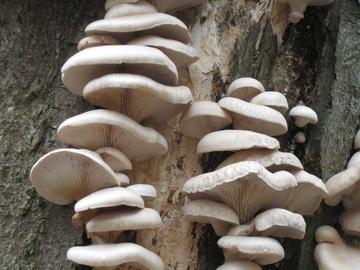Citizen Science
Citizen Science, also known as crowd science or volunteer monitoring, gives non-scientists a meaningful way to contribute to scientific research.
The Wytham Woods team are currently creating a range of activities so that permit holders can become involved in ecological monitoring. On this page you'll find out more information about our fungi and bee monitoring projects, and you can submit your fungi observations.
You can also tell us about any of the wildlife you see at Wytham by using our iRecord smartphone app and identify any insects with the help of this resource from the Oxford University Museum of Natural History.
Citizen Science Projects

What are fungi?
Fungi are largely unseen heroes of woodland. They are nature’s recyclers, breaking down dead plants and animals and releasing nutrients to be used again; others grow in and around tree roots, helping them access nutrients and water, protecting them from harmful fungi and creating communication channels between trees. Some also cause diseases of plants and sometimes animals, a natural part of healthy ecosystems.
What do they look like?
You can’t usually see most of a fungus – the mushrooms and brackets, often seen in Autumn, are just the reproductive structures; the “work” is done by a network of fungal threads called mycelium which grows within dead wood, soil or tree roots.
The photos on this page are just some examples of what the fruiting bodies of the non-poisonous Oyster Mushroom (Pleurotus ostreatus) might look like. (Photographs taken by Ann Miller).

Why do they need monitoring?
Climate change is affecting when fungi reproduce, with mushrooms turning up at different times of year; this may mean that the mycelium, which we can’t see, is also working differently.
What's happening at Wytham Woods?
We’re trialling a new method to gain a greater understanding of how one common species of fungus could respond to climate change. These logs have been colonised with the non-poisonous Oyster Mushroom. Around the logs are temperature and moisture sensors. We’re asking you to get involved and take photos of the logs so that we can track when the fungus is visible, and when it’s not. We’ll link this up with our microclimate data to look for patterns.
Where are the monitoring sites?
You will find the monitoring sites opposite the Chalet as you face downhill towards the car park and sawmill. They are on the right side of the tarmac track.
Here is an example of the signs to look for:

Submit your findings
Please use our Fungi Monitoring form to let us know what you find.
You can also discover more about fungi at this fungi blog by Martha Crockatt.
Email us your photos
To accompany your submitted observations, please email us a photograph of any fungi you see on at our monitoring stations (or indeed show us that there is no fungi there!)
Further information:
A few fun facts on fungi: https://www.bbc.co.uk/news/science-environment-45486844
An introduction to fungi: https://www.kew.org/read-and-watch/the-wonderful-world-of-fungi
Mushroom hunting challenge (kids activity): https://rspb.org.uk/fun-and-learning/for-families/family-wild-challenge/activities/fabulous-fungi/
Everything you could possibly want to know about fungi: https://www.britmycolsoc.org.uk/
We are part of the exciting initiative called Oxford Plan Bee, a project to provide a window into the world of our city’s solitary bees. Led by Dr Tonya Lander, this project has seen bee hotels set up all across Oxford.
During the summer months we aim to provide regular guided 'Bumblebee Walks', where you will be able to complete surveys of bees found along designated 'transects', which are certain areas within the Woods. If you wish to complete a bee transect on your own, you can collect equipment from outside the Conservator's Office in the Sawmill Yard; we have tote bags with everything you need inside; including identification guides, recording sheets. You can also complete butterfly transects and log your results on www.ukbms.org.



